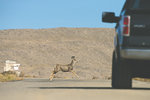Clear, 90° F
Recent research into the movements of big game animals across the Greater Yellowstone Ecosystem has yielded a slew of findings, with many of them now laid out in a new book.
Published by the …
This item is available in full to subscribers.
The Powell Tribune has expanded its online content. To continue reading, you will need to either log in to your subscriber account, or purchase a subscription.
If you are a current print subscriber, you can set up a free web account by clicking here.
If you already have a web account, but need to reset it, you can do so by clicking here.
If you would like to purchase a subscription click here.
Please log in to continue |
|


Recent research into the movements of big game animals across the Greater Yellowstone Ecosystem has yielded a slew of findings, with many of them now laid out in a new book.
Published by the Wyoming Migration Initiative, “Wild Migrations: Atlas of Wyoming Ungulates” presents maps and scientific data gathered by researchers over the past six years on seasonal migrations of the state’s wild ungulate species — elk, moose, deer, pronghorn and bighorn sheep. Herds in the Big Horn Basin are among those featured in the publication.
A rapt audience of Park County residents enjoyed author presentations and slide previews of the newly released book during a Nov. 15 event at the Cody Theater.
In introducing the project, Corey Class of the Wyoming Game and Fish Department talked about the importance of migration corridors and the relevance of the initiative’s research to the Big Horn Basin. The wildlife management coordinator in the Game and Fish’s Cody office, Class described migration as a link between vital winter and summer habitats.
In the Basin, “most of our ungulates migrate to some extent; migration is core to their survival strategies,” Class said. “If we can use this data to identify migration risks, we can be proactive in preserving these corridors.”
According to Wild Migrations co-author Matt Kauffman, the initiative’s research has yielded some important findings for big game species in Park County and the Greater Yellowstone Ecosystem.
“One of the surprises [for herds in Park County] is that these migrations have been occurring for a really long time, as evidenced in the historic record,” said Kauffman, the director of the U.S. Geological Survey’s Wyoming Cooperative Fish and Wildlife Research Unit and lead scientist of the Wyoming Migration Initiative.
As an example, Kauffman cited the research presented by co-author Greg Nickerson on prehistoric bighorn sheep traps above the Shoshone River. Nickerson projected an atlas map showing the locations of known prehistoric traps relative to present-day bighorn sheep migration routes.
“The traps are in the same location as existing corridors,” said Nickerson, providing evidence that bighorn sheep have been following these migration routes for hundreds, perhaps thousands, of years.
In addition to bighorn sheep migrations, the atlas includes information about elk and mule deer seasonal movements in Park County and the Yellowstone area. One map shows the migration corridors used by the nine elk herds that journey seasonally in and out of Yellowstone National Park. Resembling the rays of a starburst, the migration corridors arc out from the park’s rectangular boundary in all directions of the compass.
Two of these arcing lines represent the Clarks Fork and Cody herds, which were studied by one of Kauffman’s Ph.D. students, Arthur Middleton, and documented by National Geographic photographer Joe Riis in 2014-15. Middleton’s research and Riis’ photography were featured in National Geographic in 2016. Many of Riis’ striking photographs — of elk and other migrating ungulates — are included in the Wild Migrations atlas.
While the elk migration study has concluded, the Wyoming Migration Initiative team is currently gathering data on mule deer migrations in the eastern portion of the Greater Yellowstone Ecosystem. It’s an area spanning from the Wyoming/Montana border south to the Wind River Valley. Begun in 2016, the research project is following the movements of five herds. Three of these herds — the Clarks Fork, Upper Shoshone and Owl Creek/Meeteetse herds — migrate in and out of the Big Horn Basin.
As part of the project, a large collaring effort was undertaken in 2016 and again in 2017. According to Kauffman, approximately 40 individuals from each of the five herds were fitted with GPS collars. Each deer carries its collar for up to two years, to allow for data collection from two cycles of spring and fall migration.
One of the study’s initial findings is that the mule deer that winter on the South Fork of the Shoshone River migrate to Grand Teton National Park for the summer, Kauffman said.
Data from the mule deer study will be collected through 2019. Wyoming Migration Initiative scientists are using the data to look at potential threats and conservation opportunities, such as road crossings, fencing issues and residential development.
According to Kauffman, the primary concern for Big Horn Basin ungulates is not migration barriers, but winter habitat.
“Most ungulates are migrating on [U.S. Forest Service] or BLM lands, but wintering on private lands; collaboration with private landowners is key,” he said. “Subdivision is a primary threat.”
For more information, visit www.migrationinitiative.org.